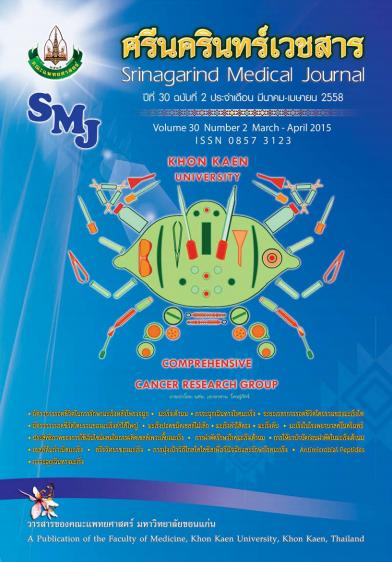Long-term Survival Outcome of Treatment for Nasopharyngeal Carcinoma in Srinagarind Hospital, Thailand: 10-year Retrospective Analysis
Keywords:
nasopharyngeal carcinoma, survival rate, radiotherapy, concurrent chemoradiationAbstract
Background and Objectives: Nasopharyngeal carcinoma (NPC) is the commonest radiosensitive cancer; however, it is still a major health problem in Thailand. The aim of this study was to assessed the epidemiological characteristics and serried survival rate of NPC treatment.
Materials and methods: A retrospective study was conducted in Srinagarind hospital, Faculty of Medicine, Khon Kaen University by analyzing demographic, clinical, and survival data of nasopharyngeal carcinoma patients from registry database of cancer unit during January 1, 2003- December 31, 2012.
Results: One thousand and one hundred ninety three patients, 849 males and 344 females, aged between 6-88 years were recruited. Two-third patients presented at an advanced stage (1.8% stage I, 5.8% stage II, 12.9% stage III, 54.0% stage IV, 25.5% unknown stage). The therapies applies include 57.8% radiotherapy, and 23.6% chemotherapy. Radiotherapy or concurrent chemo-radiotherapy is still the mainstay of treatment NPC; whereas, surgery is reserved for persistent or recurrent tumor. Overall 5-year survival rate was 39% (95% CI: 35% - 44%). According to stages, the 5-year survival rate were 63.8% (95% CI: 42.5% - 95.7%) for stage I, 55.4% (95% CI: 39.3% - 78.1%) for stage II, 48.6% (95% CI: 34.8% - 67.9%) for stage III, and 32.7% (95% CI: 27.5% - 38.8%) for stage IV. Regarding gender and age group, the 5-year survival rate was better in female group (p = 0.011) and patients who was younger than 40 years old (p = 0.010).
Conclusion: Nasopharynx is a one of the silent areas of head and neck cancer; therefore, most of patients resented with advanced stages. The clinical staging seems to be the most important prognostic factor of NPC; hence, the early concern and detection are necessary to achieve an excellent treatment outcome.




